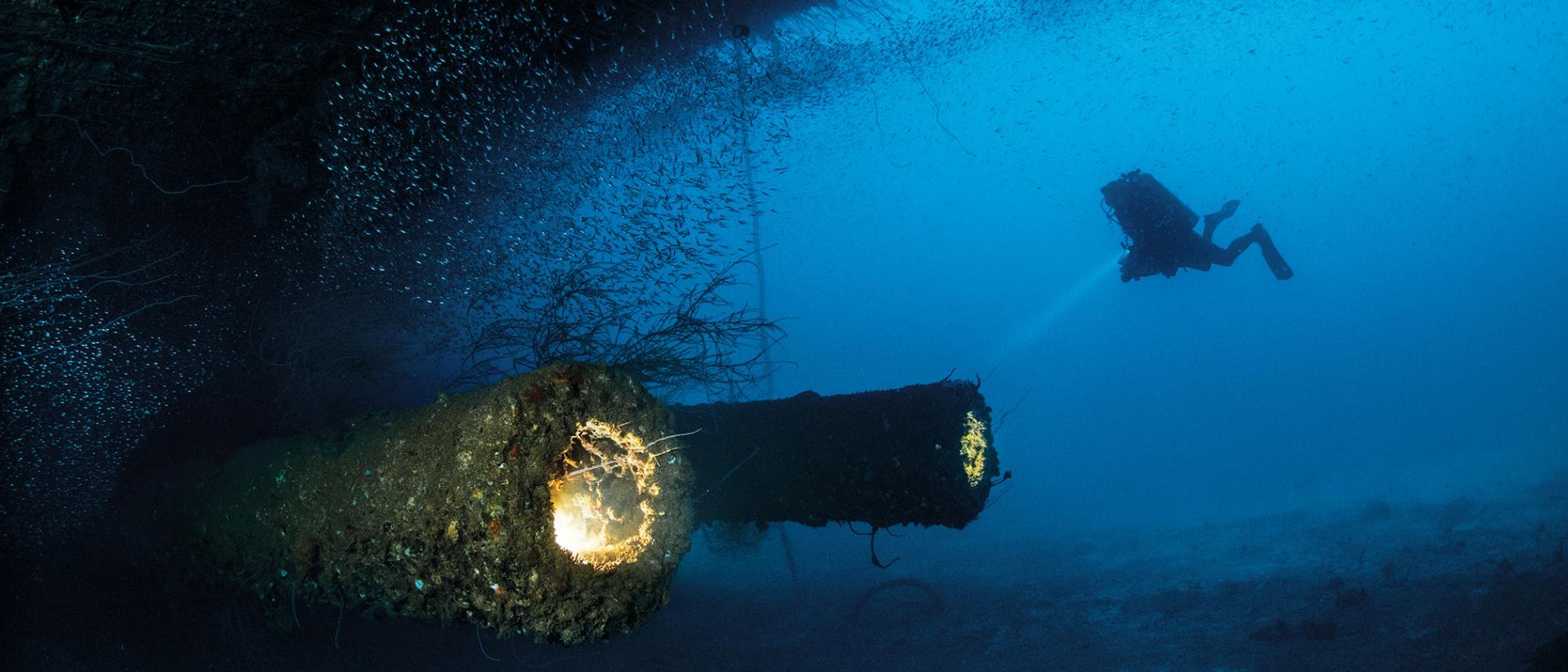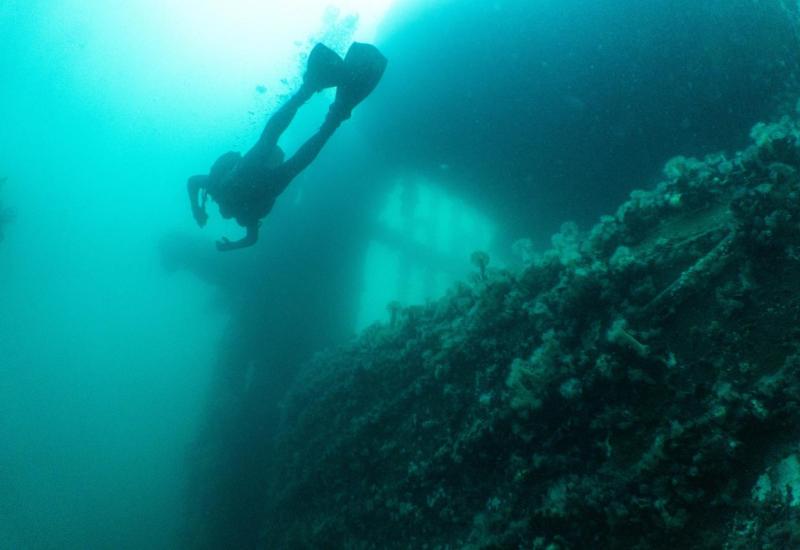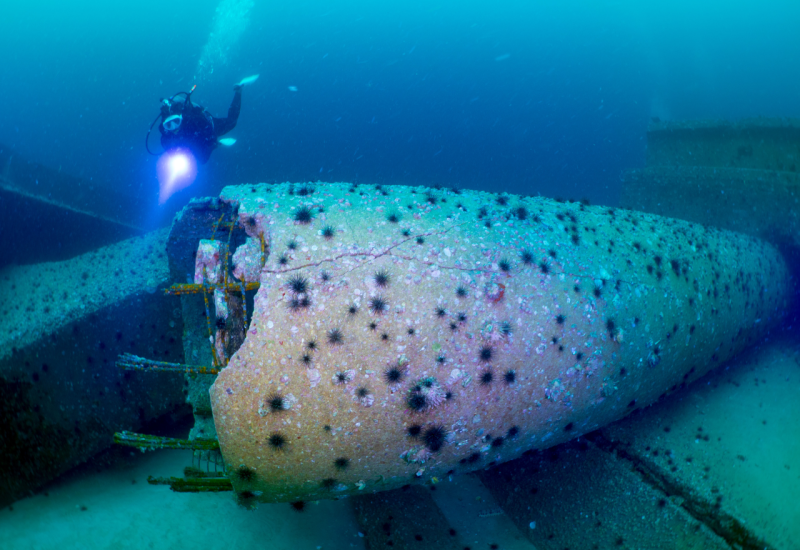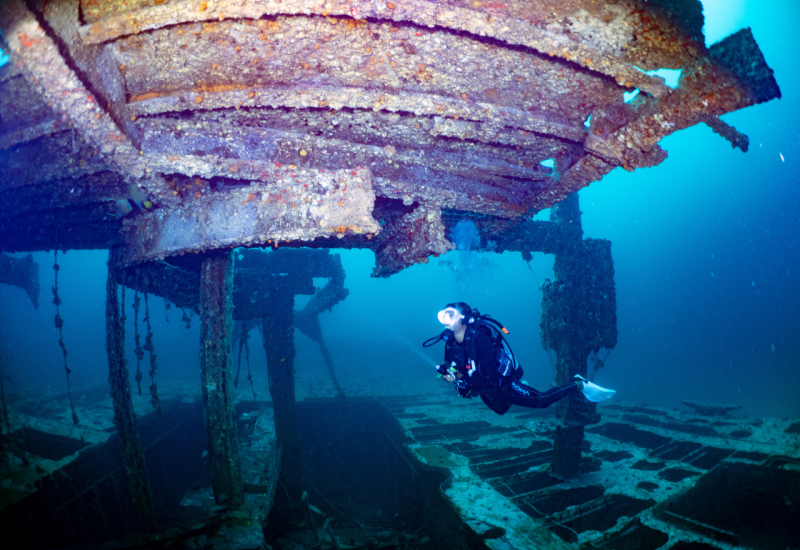The Ghost Fleet of Bikini Atoll
^^T^^he lagoon is as beautiful as Micronesia gets, a giant white-sand atoll surrounded by a wide ring of shallow turquoise water. The deeper blue of the lagoon is so saturated that it tilts toward purple, and is full of marine life. Surrounded by this paradise, it’s hard to imagine the devastation that took place here more than 70 years ago. One has to remind oneself that Bikini Atoll remains mildly polluted by radiation and is not considered safe for human habitation.
While we gear up, the welcome committee circles the boat: two young tiger sharks. The lagoon is a big nursery for sharks, its shallows brimming with juvenile white- and blacktips. In the coming days, we will see sharks on every wreck — gray reef, whitetips and several silvertips come to inspect the rare visitors. The Marshall Islands is the world’s biggest shark sanctuary, established in 2011 with a total ban on shark fishing. Ironically, in a place synonymous with utter destruction, Bikini is living proof that sanctuaries work.
We descend first on the holy grail of wreck diving: the USS Saratoga. An almost mythic name for scuba and history buffs, the legendary aircraft carrier was involved with all stages of the Pacific war, from Wake Island to Japan. “Sara” was considered a lucky vessel, having survived two torpedo and five Kamikaze attacks. Today it sits majestically upright on a white sandy sea bottom. Its full length — 888 feet — is barely graspable when descending midship on the wooden flight deck at about 100 feet, extending farther than one can see in either direction.
Its narrow superstructure stands erect, fringed by two sets of stocky gun turrets equipped with double 8-inch antiaircraft cannons, still pointing upward as if facing an invisible threat. The rear has mostly collapsed, burying Hellcat jet fighters parked under the flight deck — fortunately for divers, five hellcats were spared, hurled to the seafloor on that day in 1946. Practically complete, including propellers and guns and missing only once-top-secret dashboard electronics, the Hellcats sit beautifully on the white sand at 170 feet. Returning from them to the Sara, the colossal hull towers over us like a castle wall.
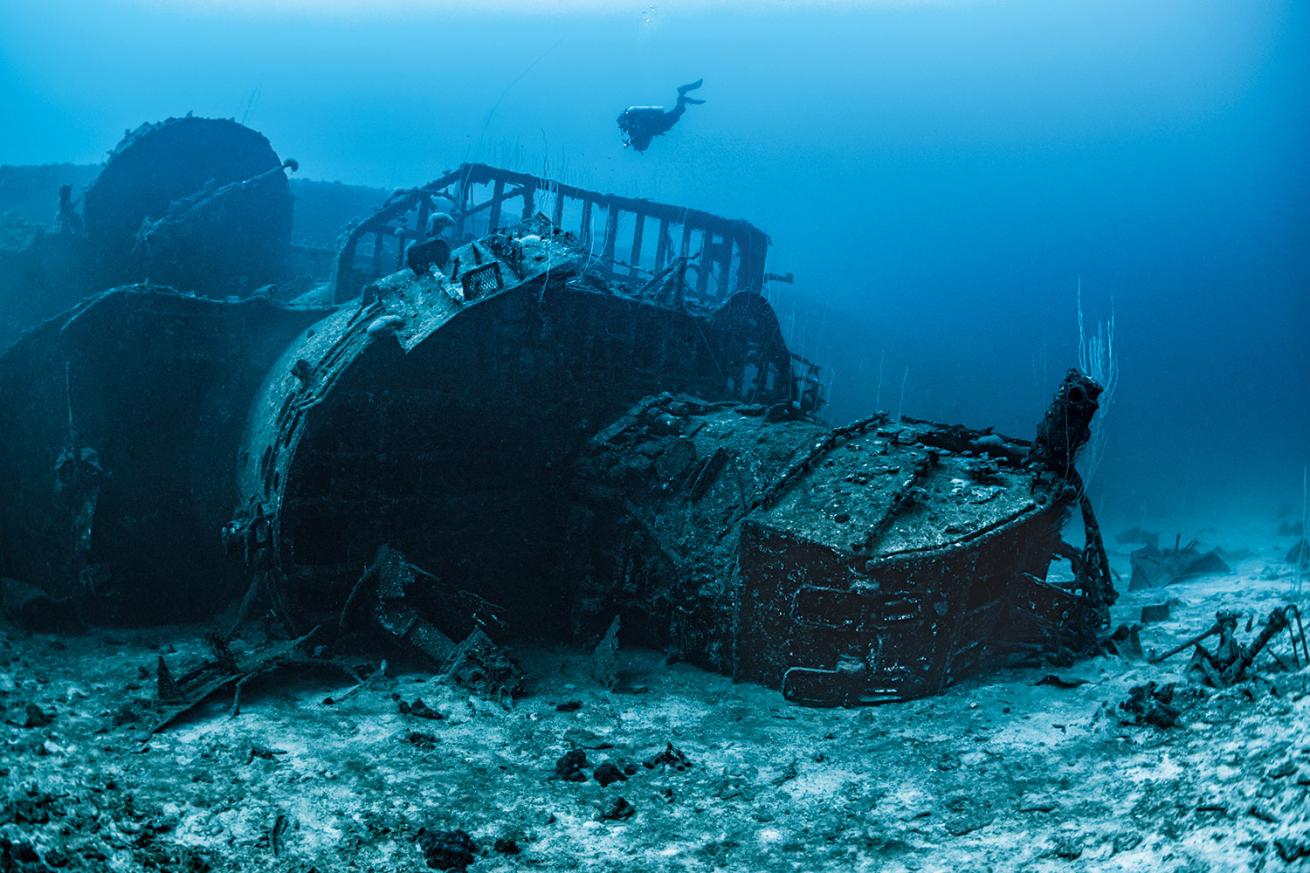
Simon LorenzThe bridge and lookout tower of WWII destroyer USS Anderson rest at 170 feet.
The Bombs
To most, the word “Bikini” conjures sun and beach; to divers it is a wreck fantasy, the mother of all ship graveyards. Bikini Atoll is unique in many ways, unrivaled by any other wreck-diving destination. Its main attraction is a fleet of 21 ships, sunk by the most powerful weapons at the time, a pair of nuclear devices tested in Operation Crossroads in July 1946.
After nuclear bombs all but annihilated two Japanese cities — and abruptly concluded the war in the Pacific — the United States realized it needed to study just how powerful this bomb really was. Not wanting to test in proximity to “civilization,” the search for a testing site led to the most northwestern corner of the newly U.S.-controlled territory of the Marshall Islands: Bikini and Enewetak. A small community of 167 Bikini islanders was swiftly resettled, beginning the ordeal of the world’s first “nuclear nomads,” which remains unresolved more than 70 years later.
A massive operation was set up involving 42,000 Army and Navy staff, 242 ships, 156 airplanes, and thousands of test animals. The tests were intended to study the effects of aerial and subaquatic nuclear bombs on naval fleets and living beings, and to demonstrate the superiority of U.S. military power to the world — and particularly to its superpower rival, the USSR. Two tests were conducted, “Able” (aerial) and “Baker” (aquatic), which included around 75 target vessels each, all combat-ready, stocked with fuel, ammunition, torpedoes and airplanes, and manned with thousands of goats, pigs and rats.
The first — Able, dropped from a bomber July 1 — created a fireball 1,500 feet in diameter, so blazingly hot that it started fires on boats almost 2 miles away. It sank five ships, immobilized six and destroyed superstructures across the fleet. Photos of its smoke pillar made headlines around the world — persuading Louis Reard to name his scandalous new two-piece swimsuit after the island. Diving some of Able’s victims today, its immense power is clear. All structures of the attack transporter USS Carlisle are a tangled mess; the bomb devastated everything from above. A steering wheel remains intact but oddly bent, demonstrating the power of this weapon.
Aquatic bomb Baker was even bigger, releasing power equivalent to 23,000 tons of TNT. An underwater fireball erupted into the world-famous mushroom cloud of evaporating ocean water, its stem measuring 1,000 feet across and reaching a height of more than 4 miles. The explosion shook the area with a seismic effect of 5.5 on the Richter scale, creating a tsunami-like wave of 100 feet. The combination of the massive wave and the underwater force sank nine vessels almost immediately and badly damaged another 11 that would sink in the coming days and weeks. Solid steel hulls built to withstand torpedo attacks ruptured like toys. The destroyer USS Arkansas — placed close to the Baker target site — had its triple-coated 11-inch shell-plating bent into 5-foot-deep grooves, like a soda can squeezed by a giant hand. The ship was immediately capsized; divers can see where the massive force drove the entire superstructure deep into the coral sand of the lagoon. Its huge guns must have swung around wildly, coming to rest at odd angles, where they remain more than 70 years later.
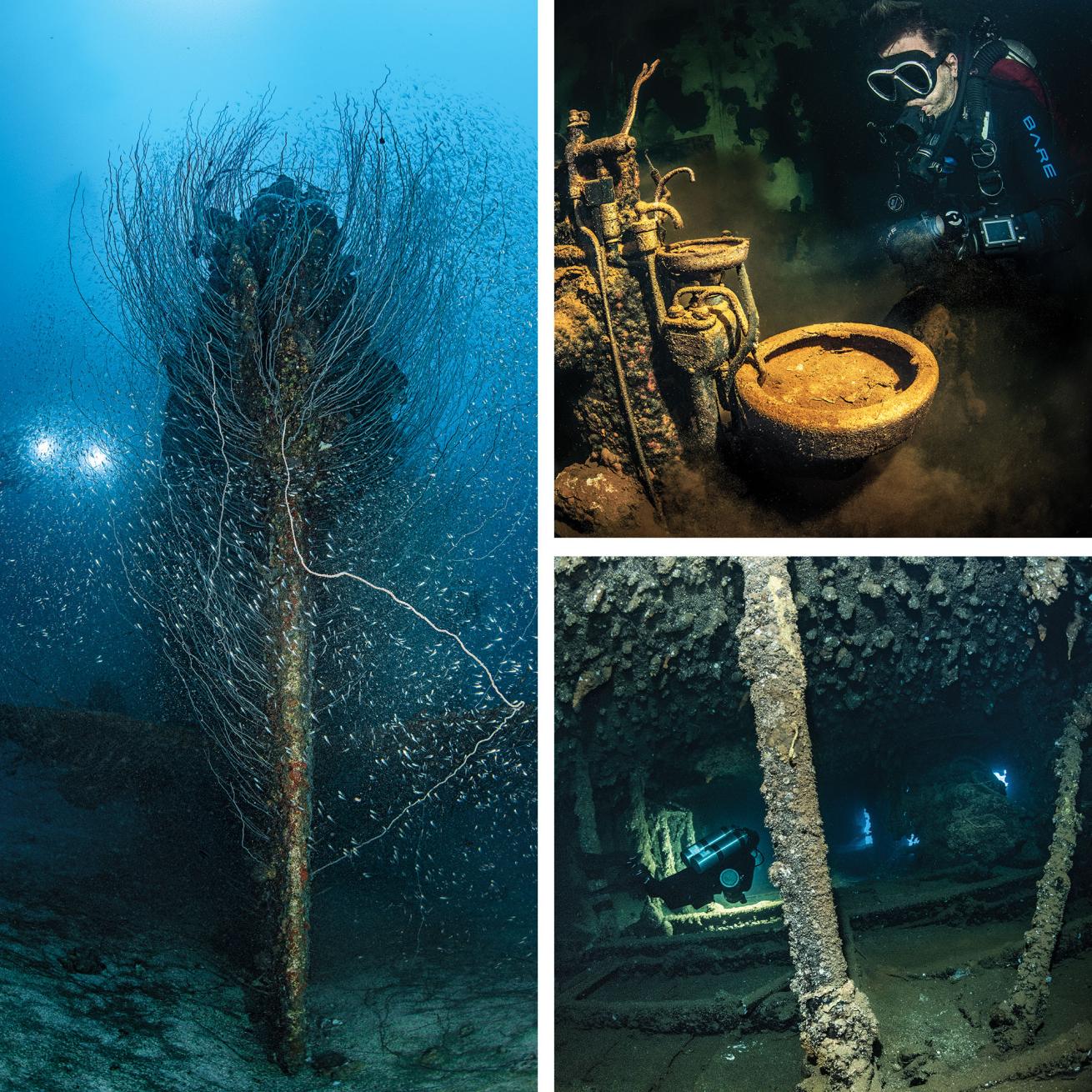
Simon Lorenz(Clockwise from left) The rudder of perfectly intact submarine USS Apogon; sick bay on USS Saratoga; upside-down gun deck of USS Arkansas.
Even more devastating was the fallout. More than 2 million tons of boiling seawater and another 2 million tons of lagoon bottom sprayed the fleet and the neighboring islands with radioactive material, 20 to 30 times the lethal amount, within the first hour. Thousands of Navy and Army sailors received deadly doses of radiation in the coming days, a long-term health threat that was poorly understood at the time and broadly neglected by military managers.
Over the next dozen years, the U.S. would test another 65 bombs in the atoll, where many reefs were blown to bits, and several islands ceased to exist entirely.
The tests also created one of the most unique wreck-diving destinations on the planet. The first monitoring expeditions and film crews came in the ’80s and ’90s. They discovered an unusual ghost fleet of fully armed Japanese and U.S. destroyers scattered around the lagoon, as well as submarines and a world-famous aircraft carrier, with World War I and World War II vessels lying side by side.
Until recently, visiting was difficult and uncomfortable. Radiation was still considered a threat, so scuba divers only rarely made it here, arriving on occasional charters. For a few years there was a tiny dive shop, but it did not survive due to the difficulty of travel there. In 2018, Truk Master liveaboard began running Bikini trips five months of the year, making the nuclear ghost fleet accessible to qualified divers.
The Ships
We are picked up in Kwajalein, a U.S. base on the regular island-hopper route between Guam and Hawaii. After we are shooed through a lengthy security screening in a boiling cement room, a military escort brings us to a ferry to neighboring Ebeye Island, where our liveaboard is anchored. From here it’s another 25 to 30 hours at full steam — in favorable conditions — to Bikini Atoll.
Saratoga is the go-to first dive because it is the shallowest wreck, with the deck at 100 feet and much of its superstructure still intact; it’s also where we will do most of our penetration dives. It features a radio room, scullery, locker rooms, an armored wheelhouse, machine room, a command center complete with microphone desk and screens, and a sick bay with three dentist chairs. Cutlery, dishes, electronic equipment and deep-diving helmets litter various rooms. Sediment in these wrecks is so powdery that silt-outs happen quickly and frequently, complicating photography. The number of artifacts shows that not much looting has taken place — diving among the remains of this naval giant is as good as wreck diving gets.
Other wrecks in the atoll are also packed with equipment. The 708-foot HIJMS Nagato, superbattleship and pride of the Japanese navy, rests upside down on the turrets of its eight massive 16-inch guns. Admiral Isoroku Yamamoto famously gave the command to attack Pearl Harbor from this ship in 1941. Today the bridge where Pearl Harbor’s fate was decided has broken off and is lying next to the overturned hull. Its four huge props stick out like windmills, surrounded by clouds of glassfish.
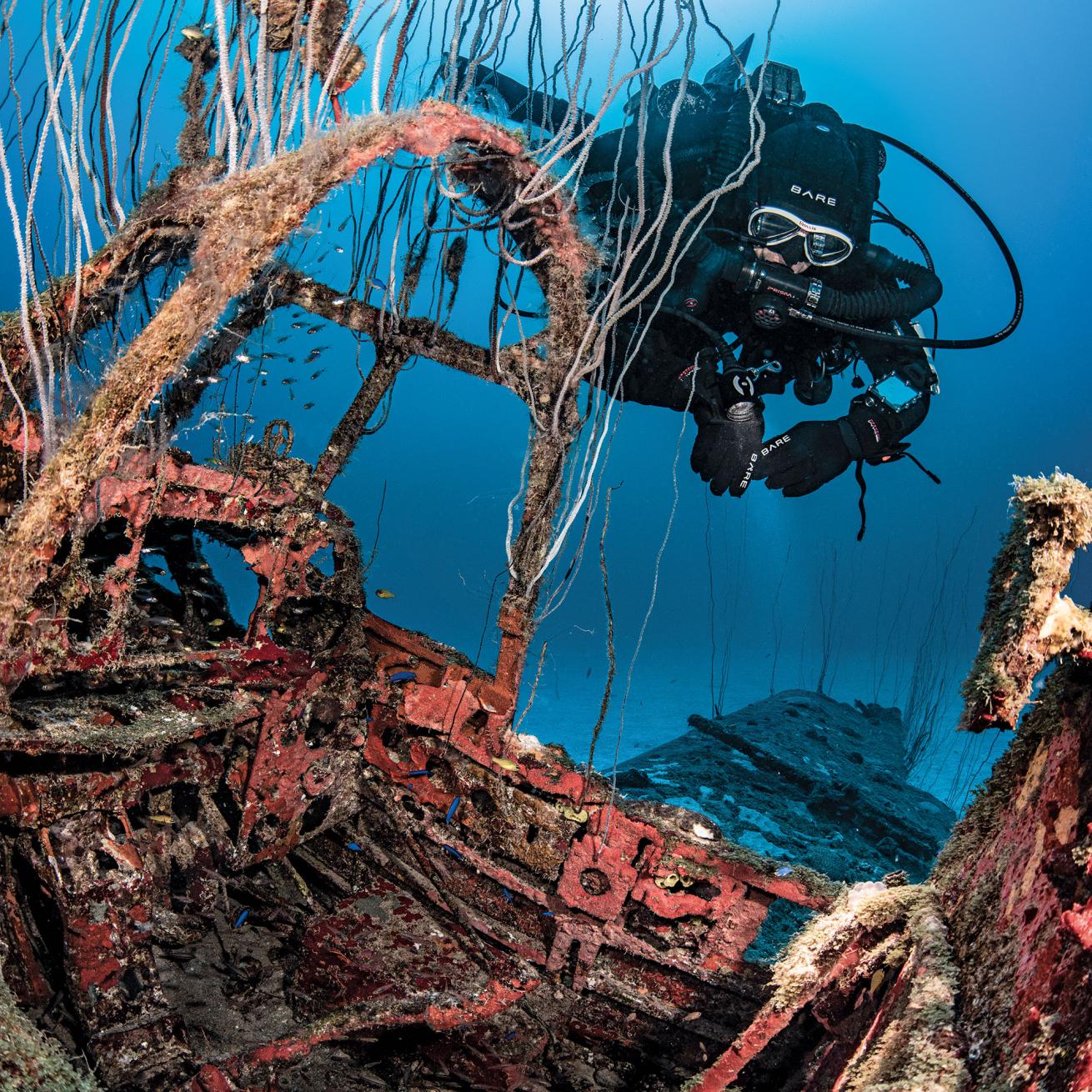
Simon LorenzHellcats jettisoned from the sinking USS Saratoga rest on the sandy seafloor at 150 feet.
Next we dive the 562-foot flagship destroyer USS Arkansas, which rests at 170 feet. Built to win sea battles through superior firepower and speed, this ship played an important role in both WWI and II, from the occupation of Veracruz, Mexico, to Normandy, Iwo Jima and Okinawa. This nearly indestructible marvel sank within moments of the Baker blast. It is also upside down on the seafloor, with massive cannons pointed outward. One of its gun decks is accessible by slipping through the gun port. Inside, the mounts that used to hold wooden flooring hang down onto the gun controls like stalactites.
Other great dives are the smaller destroyers USS Anderson (345 feet) and USS Lamson (348 feet), complete with live 21-inch torpedoes and fully loaded depth-charge racks. The refashioned merchant vessel USS Carlisle sank as the aerial Able bomb compressed its hull like a tin can — this dive gives a good sense of nuclear devastation on civilian targets.
All ships in the lagoon are encrusted with bizarre coral growth and seem to have their own marine ecosystems. Unlike the fleets of Truk and Palau, only a small amount of hard and soft corals have managed to make homes of these hulks, leaving artifacts conveniently intact for divers to see. However, on all hulls, props, guns and other large extensions are forests of long whip corals surrounded by millions of glassfish. Some ships, such as the beautiful submarine USS Apogon, are entirely engulfed in glassfish clouds that move like mystic fog, creating an apt atmosphere for these ghost ships.
What It Takes
All wrecks are deep, so technical certification to 170 feet is required. Advanced wreck certification and ample experience in overhead environments at depth is recommended. Good buoyancy is paramount for penetrations because Bikini’s fine silt clouds at even the slightest water movement. Rebreather divers should know their equipment inside out, and be able to do repairs themselves.
The Radiated Island
Despite its beautiful white-sand beaches, balmy turquoise waters and green palm trees, Bikini Island still feels eerie — well-maintained but deserted. The island would see another 21 tests after Able and Baker, polluting it for the coming century and preventing a return by Bikinians to their ancestral grounds.
Only remnants of those times remain, apart from some derelict bunkers. What is left is a village built when, for a time in the 1970s, it was deemed safe to return. After discovering that the “silent killer” still polluted the soil, groundwater, coconuts and crabs, the village was again abandoned, and now is maintained by a revolving crew of seven Bikinians who keep the place tidy for visitors and the eventual hoped-for return of their community.
Today groundwater, plants and animals still show radiation that could lead to illnesses, making permanent settlement here impossible. It is considered safe to visit because all food and water is imported.
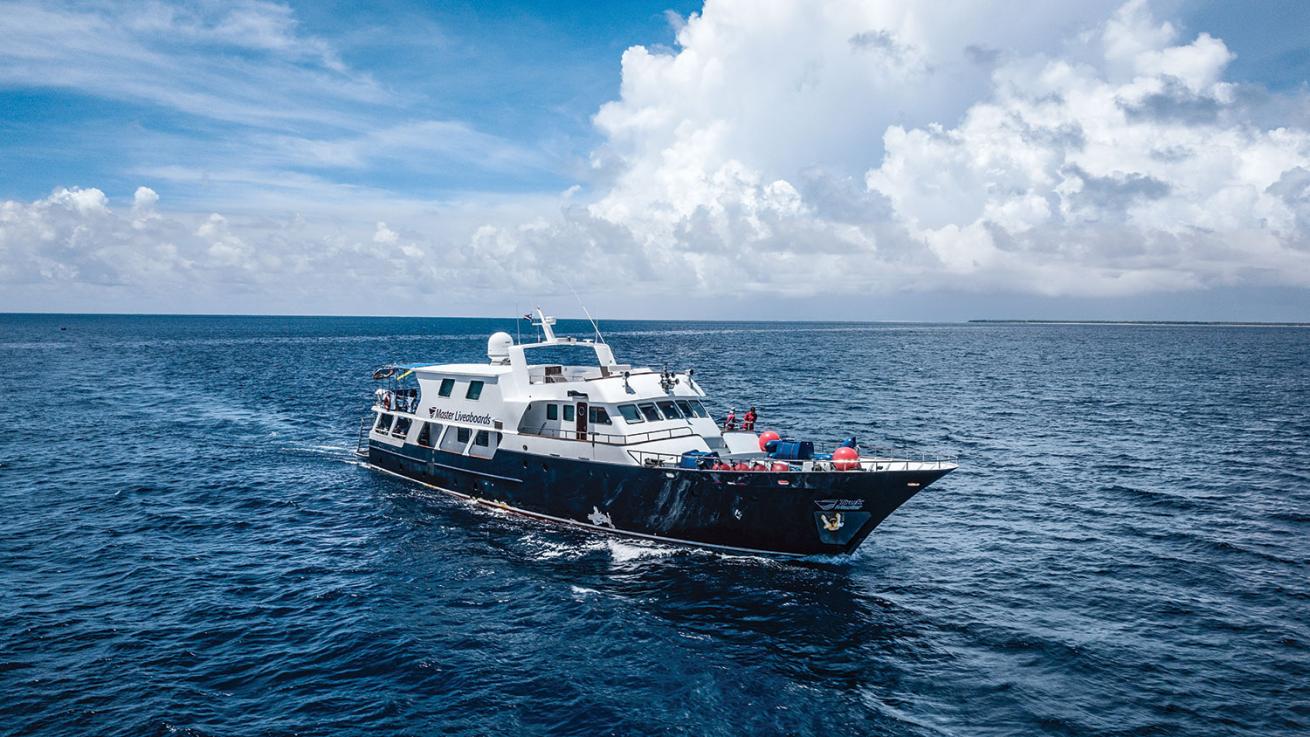
Master LiveaboardsTruk Master is part of the Master Liveaboards fleet. The four-deck, steel-hulled yacht carries 16 divers on its Truk cruises; Bikini itineraries are limited to 11 divers.
Need to Know
When to go: Truk Master visits Bikini June to September.
Dive Conditions: Water temps are in the mid-80s; visibility is mostly very clear. Bikini wreck dives are to depths of 130 to 160 feet; deco stops are often 60 minutes and longer, so a 5 mm wetsuit is recommended. Due to the remoteness, all divers including rebreather divers dive on conservative gradient factors. Regardless of these precautions, we had several cases of mild skin bends as well as ear and head maladies; Bikini diving is tough on the body, and should not be underestimated.
Price Tag: It’s $6,900 for an 11-night cruise or $8,500 for 14 nights, not including gas mixes and a $500 park fee.
Travel Tip: United Airlines flies to Kwajalein four times a week from Hawaii or Guam.

